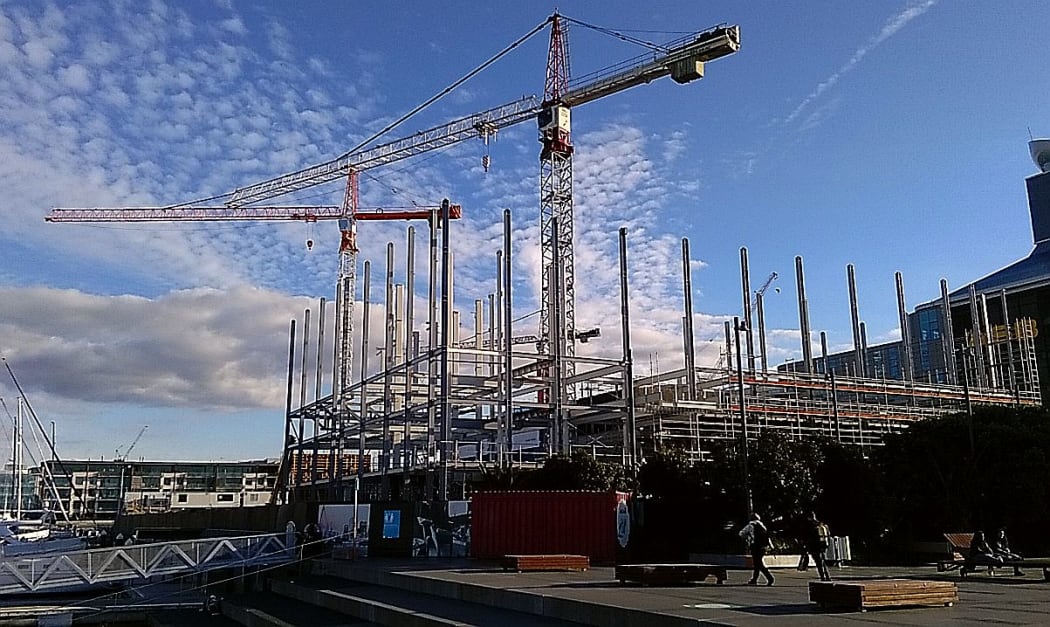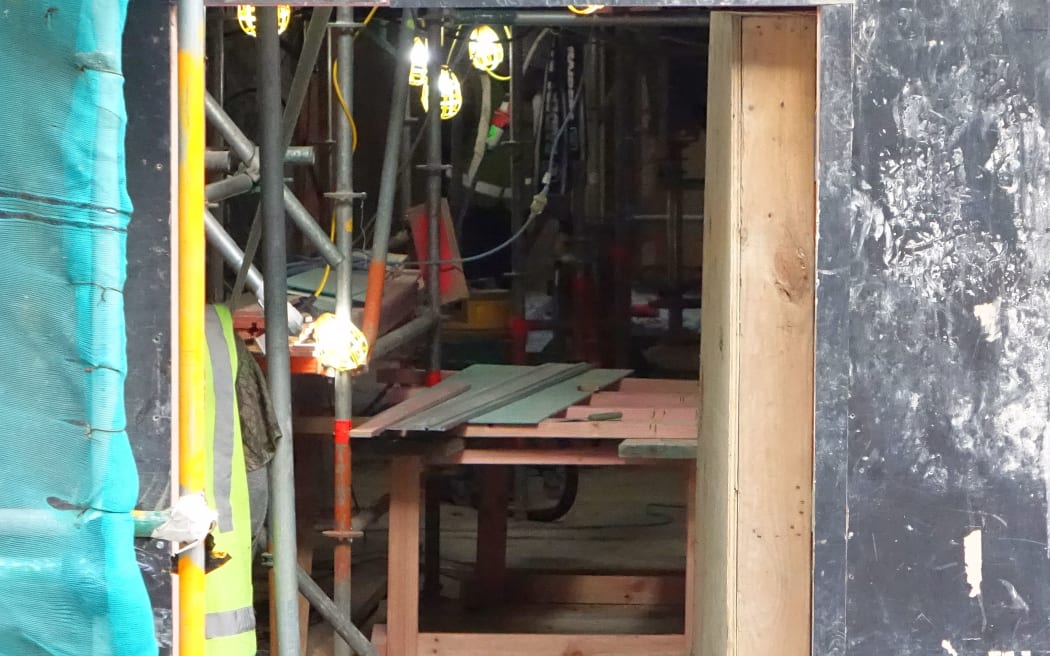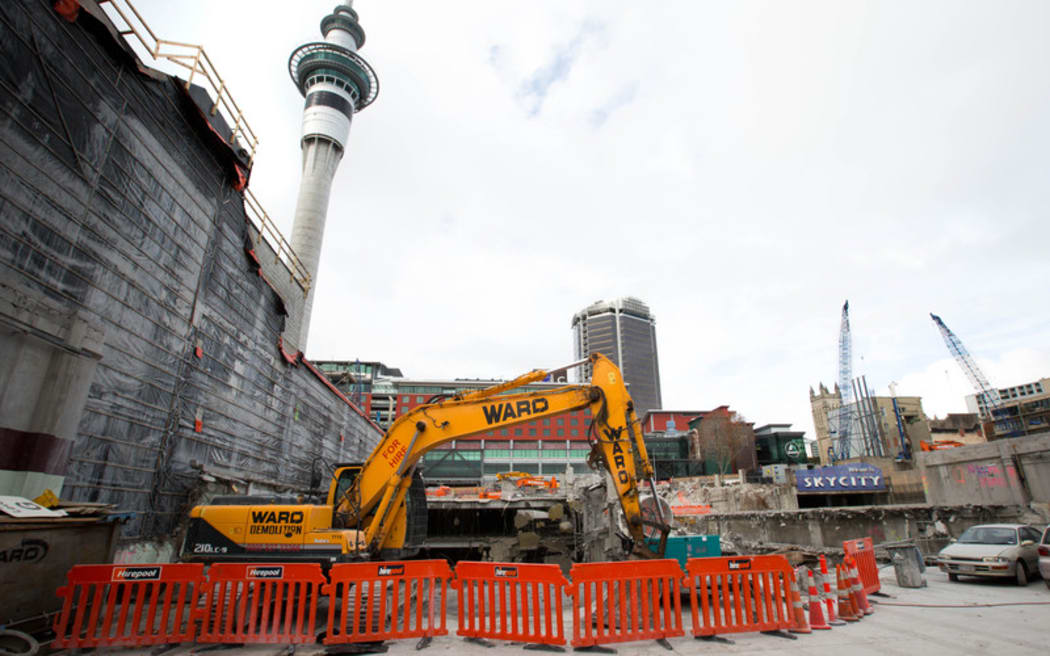An unprecedented construction boom is generating thousands of jobs and big profits. It's also inflicting some big losses and exposing a web of weak points in an industry prone to cutting corners on quality and safety.

A Park Hyatt hotel being constructed in Auckalnd's Wynyard Quarter Photo: RNZ / Phil Pennington
Ron Green, Terry Johnson and John Goddard are well used to finding faults. The first is a fire protection specialist, the second an expert in earthquake restraints, the third a lawyer.
The deficiencies they have seen in the course of their jobs - often-times faults that builders wished they hadn't spotted - have filled each of them with a deep disquiet about the state of New Zealand's construction industry.
Mr Green's daily job sees him poking into electrical cupboards, and nosing into the ceiling cavities of multi-storey buildings.
He said it was common to find holes and bad sealing in apartment blocks, hospitals and rest homes, which would let flames and smoke spread quickly.
"Some people have come a long way but a lot of people haven't," Mr Green said.
"A client I was working for, they cancelled their contract because they obviously thought I was too strict, whereas all I'm doing is trying to help them make sure their building's safe."
Dry and dusty standards and bureaucratic box-ticking do actually matter, the starkest recent reminder being London's Grenfell apartment tower fire in June.

The charred remains of cladding are pictured on the outer walls of the burnt out shell of the Grenfell Tower block in north Kensington, west London, on June 22, 2017. Photo: AFP
At least 80 people died in the blaze, the ferocity of which was linked to the combustible cladding used on the outside of the building.
This type of cladding was banned on New Zealand high-rises this year, but existing buildings with such cladding may not be forced to remove it.
Nick Smith said each building that had the cladding would need a full assessment of overall fire safety.
Building product quality is one issue, design and construction practices are another.
The collapse of the CTV building which killed 115 people in the February 2011 Christchurch earthquake, and the failure of the 12-year-old Statistics House in Wellington in last November's quake, were both because of design flaws.
Quake restraints expert Terry Johnson said the flouting of earthquake restraints in ceilings was even worse than the non-compliance over passive fire protection standards.
He said in 30 years there had been fewere than one building built per year that was fully compliant.
"It's not a failure rate. You can't have a failure rate if you've done nothing," he said.
Now working for Morrison Kent in Wellington, John Goddard helped lead a team that did 500 engineering assessments and mounted 4000 legal challenges over potentially substandard house repairs following the 2011 Christchurch earthquake.

WCM Legal solicitor John Goddard Photo: ( RNZ / Phil Pennington )
"There are just not sufficient checks and balances around the level of construction monitoring, who is signing off on [it], and the quality of building work which is being carried out," he said.
Mr Goddard estimated there were 10,000 shoddy repair jobs all up, and just seven notices issued by the city council to fix them.
The scale and extent of deficiencies in New Zealand is also kept hidden by the cost to builders' careers should they go public with any problems.
Insight is aware of an Auckland engineer who was moved to another job when he refused to accept some untested steel on a big public project.
Mr Goddard is urging the government to set up a whistleblower agency and improve disclosure protection, but the Ministry of Business, Innovation and Employment said it was not even looking at such an option.
Out on the building site, there are few resources to actually find deficiencies. The ministry only has three field investigators across the whole country, and they oversee labour exploitation and immigration issues as well as the building industry.
When asked why it tolerated widespread non-compliance with earthquake restraint rules, the Ministry of Business, Innovation and Employment said that "checking that is the responsibility of councils for individual buildings".
"MBIE has issued a practice advisory on this, which is our role."

Building under construction in Boulcott St In Wellington Photo: ( RNZ / Phil Pennington )
Mr Goddard said the heart of the problem was this delegation of hands-on power to local councils even though the ministry did not trust them to get it right.
It is understandable the 69 councils that issue building consents are struggling. They generally do not have enough experienced building control officers, and efforts to provide better training have hit obstacles.
Senior engineers talk about a "gradual dismantling" of in-house engineering expertise at councils.
"Those engineers that are still in building consent departments are overworked and underappreciated, and generally are pushed into administrative roles," one engineer who Insight agreed not to name, said.
"In the absence of detailed reviews by the building consent authority [council], there is some gaming of the system.
"Whether deliberately or through ignorance, who knows."
The plethora of standards and multiple pathways to compliance are confusing even for seasoned building officers.
The pressure is greatest in Auckland. Inspectors are assigned just 45 minutes to do a regular inspection, including paperwork and travel time.
Senior sources who work in the area of council building control, who again spoke on condition of anonymity, said , there was too little supervision by contractors on building sites, especially of untried staff. That held true even as the balance of experienced and inexperienced workers grew increasingly skewed.
One source said some project managers were supervising up to 20 residential building sites on their own.
"It is worse than leaky buildings," said another.

Photo: RNZ / Cole Eastham-Farrelly
What is going right?
The industry hardly has time to catch its breath such is the demand, especially in the main population centres. Even so, there is growing recognition of the scale of the problems and the need for urgent, far-reaching change.
There is, after all, evidence of some tightening up around building quality.
The number of laboratories accredited to test steel-reinforcing mesh has more than doubled from last year, from three to seven.
The ministry is also pushing through the first major restructure of the Building Performance branch in years. It is adding 22 positions, including two or three in product assurance.
This public sector reform is being matched by a new move within the industry itself for rapid, far-reaching change.
Five white-and-red cranes tower over the noisy International Convention Centre building site in central Auckland. Emblazoned on the underside of one crane in huge letters is the slogan, "Greater knowledge, better skills".
It's could be read as a statement of fact, or as a clarion call, or both.

Building booms can be as dangerous as busts according to Connal Townsend the head of the Property Council of New Zealand Photo: ( RNZ / Phil Pennington )
The talk is of transforming the whole way the industry operates, of reversing the "race to the bottom" in which companies under-bid each other to win a tender. This process can result in companies scrambling to find savings on site, even if that means sacrificing quality control.
One of those leading the push for change is Property Council head Connal Townsend, who is on both the ministry's reconfigured building advisory panel, and on the industry's transformation leaders group.
"I don't think we're heading for a disaster," he said, "but we will be in a disaster unless as a nation, people kind of understand the importance of this and the efforts that are being made to put it right, get proper support."
Slow and somewhat unsteady
The problems faced by New Zealand's building industry also do not exist in isolation. There is a wide body of international research showing countries around the world face similar problems:
- Construction has the lowest productivity gains of any industry, up 1 percent a year in 2 decades, one-quarter the rate for manufacturing. Trends in rich countries are especially bad. Source: McKinsey Global Institute
- Construction is among the least digitised sectors in the world. Source: McKinsey Global Institute
- Construction is one of the most fragmented industries and there's little collaboration. World Economic Forum
- Some 90 percent of the world's infrastructure projects are either late or over-budget. Source: Saïd Business School at Oxford University
- Two examples: Berlin Brandenburg Airport was meant to open in 2012 for $3 billion. It's still not open and has cost $9 billion so far. Apple's new Silicon Valley HQ was late and almost $3 billion over budget.
- Building industry sentiment survey 2017 NZ
- Building growth forecast 2017 NZ
- World Economic Forum report on global construction trends


